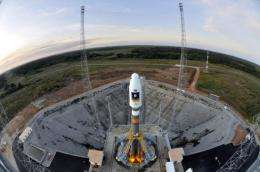Europe sets sights again on Soyuz launch

Engineers were eyeing a second bid at the historic launch of a Soyuz rocket from Europe's space base in South America after a countdown was scrubbed by a refuelling hitch.
The Soviet-Russian lifter, which traces its ancestry to the dawn of the space age more than half a century ago, is set to make its first launch outside of Russia's bases.
It is carrying the first two operational satellites in the Galileo project, Europe's answer to the United States' Global Positioning System (GPS).
Thursday's countdown was cancelled around two hours before liftoff after a problem surfaced in a pneumatic system on the launch pad gantry.
The system is designed to disconnect fuelling lines to the rocket's third stage just before flight.
"During the final phase of third stage-fuelling, there apparently was a change in pressure in this pneumatic system, and we observed the unplanned disconnection of the two connectors that enable the fuelling of Soyuz' third stage with liquid oxygen and kerosene," the head of launch operator Arianespace, Jean-Yves Le Gall, told reporters on Thursday.
"The problem apparently is due to a valve leak in this pneumatic system, and we have taken the decision to empty the launcher and replace the valve."
The launch was rescheduled to 1030 GMT on Friday.
It is the first launch under a 2003 deal to deploy the rocket beyond the historic Soyuz bases in Plesetsk, northern Russia, and Baikonur, Kazakhstan.
With Soyuz, Arianespace hopes to complete its range of launch vehicles, placing a medium-weight lifter alongside the heavy Ariane 5 and a future lightweight rocket, the Vega.
The 5.4-billion-euro (7.2-billion-dollar) Galileo project is designed to comprise 27 operational satellites and three spares by its completion in 2020.
It should give geopositioning accuracy to within a metre (3.25 feet), whereas the GPS is currently accurate to between three and eight metres (10 and 26 feet), according to official websites.
(c) 2011 AFP



















